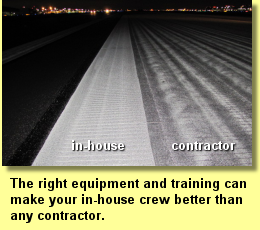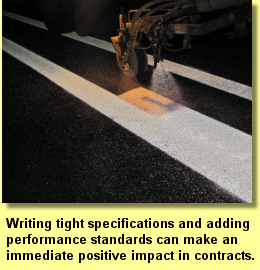 |
 |
In-house vs. ContractorBy Mike SpeidelSightline is not a Human Resources consulting firm, but clients seemingly think it is. In the last several years of auditing airfield marking systems, we have continually been presented with questions about airport personnel - "Do we have enough people?" - "How many is an ideal crew size?" - "Should we contract more/less of our striping out?". The last question is asked most often. Clients often want to know if they should lean on their in-house maintenance staff to maintain the markings or send it out to bid. Frankly, there isn't a standard answer because every airport is unique. However, there are certain things any airport should consider when choosing to invest in their own personnel/equipment versus putting an RFP out on the street. In-house Crews
The benefits of employing in-house crews include:
The Catch: Paint crews typically rely on past experience from trial and error; their knowledge (right or wrong) is tribal in nature and is passed throughout the group. The key to getting the most out of an in-house crew is making an investment in it. Specifically, providing personnel training and equipment tailored for the job are common recommendations we make to several clients. An in-house crew, like contractors, need the right tools and methodology to be efficient and achieve high quality markings that last. Contractors
The benefits of using a contractor include:
The Catch: Contracts are often procured through a low-bid system to encourage competition and discourage steering the contract. Therefore, it is a bit of a crap shoot as to how qualified your contractor will be. There are good contractors and there are bad contractors like in any industry. Just because you're spending the money on a specialized contractor doesn't mean you can take for granted you'll receive a quality project. The key to getting the most out of a contractor is writing tight specifications, to include reasonable performance standards and comprehensive quality control measures. There is no one way to go about maintaining your markings. Either way, it's a considerable investment and commitment. Make sure you're thorough in your approach this year. If you need an unbiased perspective, contact our HR department (me) via email. |

 In general, the larger the airport, the more likely it has an in-house Facilities/Maintenance team responsible
for painting, among many other things. It makes sense with the huge demand for maintenance at larger ports, and it is often
cost prohibitive to contract it all out.
In general, the larger the airport, the more likely it has an in-house Facilities/Maintenance team responsible
for painting, among many other things. It makes sense with the huge demand for maintenance at larger ports, and it is often
cost prohibitive to contract it all out.
 In general, the smaller the airport, the more likely it outsources its airfield striping. Personnel and budgets
are more limited making it difficult to justify the initial investment required to acquire equipment and the staff to operate it.
Hence, bringing in a specialist to maintain once in awhile makes fiscal sense.
In general, the smaller the airport, the more likely it outsources its airfield striping. Personnel and budgets
are more limited making it difficult to justify the initial investment required to acquire equipment and the staff to operate it.
Hence, bringing in a specialist to maintain once in awhile makes fiscal sense.